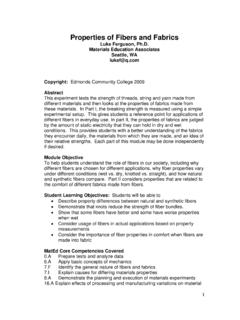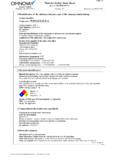Transcription of Hardenability of Steel: the Jominy Test
1 1 Hardenability of steel : the Jominy Test Andrew Ruble Department of Materials Science & Engineering University of Washington Seattle, WA 98195 Abstract Controlling a material s properties during processing is pivotal for any engineering field. A specific hardness for a metal is often a desirable characteristic for many applications, so controlling hardness is important during processing. To increase the hardness of steel , it is often quenched from a high temperature to form martensite, a hard yet brittle phase of iron. The extent of martensite formation , including hardness and depth of formation , is known as Hardenability . This module provides a classroom lesson and a lab experiment for measurement of Hardenability in a high-carbon steel according to, the Jominy End-Quench Test , (ASTM A255 10). The demonstration exercise involves quenching one end of a heated steel sample and comparing evaluating the hardness distribution using measurements obtained at different locations on the sample surface.
2 Module Objectives Introduce students to the concepts of Hardenability Demonstrate Hardenability in a steel Display the effects on microstructure of the hardening process Provide instruction for a full lab experiment on Hardenability (if equipment is available) Student Learning Objectives The student will be able to Define Hardenability and its importance in processing Determine a metal s Hardenability with the Jominy End-Quench Test Create and interpret a Hardenability curve 2 MatEd Core Competencies Covered Prepare Tests and Analyze Data Demonstrate Laboratory Skills Identify the General Nature of Metals Demonstrate How Materials Properties are Used in Engineering Design Demonstrate the Planning and Execution of Materials Experiments Perform Appropriate Tests of Metallic Materials Define and Describe Constituents, Properties and Processing of steel Describe Techniques used for Metals Processing Key Words: Hardness, Hardenability , Jominy test, Quench, steel Type of Module.
3 PowerPoint presentation with discussion and lab or in-class demonstration depending on availability of equipment Time required: two 50 min sessions if the lab is undertaken; one session for the in-class presentation Suggested prerequisite MatEdu modules: 1. Introduction to Hardness 2. Iron and steel : Properties and Applications 3. Phase Change Experiment Target grade level: Advanced High School, Introductory College/Technical School Equipment and Supplies for the demo and lab: PowerPoint projection system Electric Furnace at least 5 tall, capable of 1100 C Metal tongs, protective gloves, face shield (depending on furnace) Water-quenching device and apparatus for holding specimen (see appendix for diagrams of a simple apparatus that can be built by students) Jominy samples 1 diameter by 4 length cylinders from or similar Chop saw Belt grinder Rockwell Hardness Tester 3 Table of Contents.
4 Abstract 1 Module Objectives 1 Student Learning Objectives 1 MatEd Core Competencies 1 Equipment and Supplies 2 Curriculum Overview 3 Module Procedure 6 Evaluation 7 Supporting Materials 7 Acknowledgements 8 Curriculum Overview As iron is processed, certain elements are added to achieve specific mechanical properties. The iron may also undergo quenching, a heating and rapid cooling process, that is performed to increase hardness. When heated and rapidly cooled in a quench, steel will form a phase known as martensite, which has high hardness. Hardness is also inversely proportional to the grain size of a metal, which is a large factor in determining other characteristics as well. Because of this, hardness can be used to anticipate these other characteristics. For example, as hardness increases, so does tensile strength. Through the application of selected processing steps, Manipulating the hardness of a metal during processing can help improve can be controlled or improved to adjust these characteristics of the metal as appropriate for the application.
5 Iron alloys vary on the amount of martensite that can be formed due to differences in alloying elements, so the idea of Hardenability was developed. Hardenability is the ability of a metal to improve hardness and martensite formation through quenching. The extent of martensite formation in the steel at given distance from the quench, which can be determined by hardness testing in several areas of a sample, is what Hardenability measures. Hardenability also determines the necessary cooling rate, fast or slow, for martensite formation . The Jominy End-Quench test determines Hardenability of any variety of steel , and is straightforward due to its simplicity and minimization of variables. The size and shape of the sample are standardized as well as the quench process, so the extent of martensite formation can be compared quantitatively between different steels. And since steels have similar thermal conductivity, the distance from the quenched end correlates to a certain cooling rate.
6 Knowing this, the hardness of a metal cooled at a given cooling rate can be accurately predicted from the Jominy test results. 4 The PowerPoint presentation reviews the experimental procedures, which are summarized below. Test Procedure Figure 1: The setup of the Jominy End-Quench test The procedure for the Jominy End-Quench test is as follows: place the Jominy sample upright in a 1000 C furnace for 30 minutes to create a phase known as austenite completely through the sample. Before removing the sample from the furnace, prepare the water for the quenching the end of the sample in the Jominy setup. The water spray should extend vertically without the sample in place, and the bottom of the sample should be above the water opening. Remove the sample using extreme caution and place it into the mounting fixture, as seen in figure 1, taking no longer than 5 seconds for the transfer.
7 Apply water for at least 10 minutes, and if the sample is still warm, place sample in room temperature water until cool. The next task is to measure the hardness of the sample. Using the chop saw, cut the cap from the sample to create cylinder and mark the top. Create a flat edge, using a grinder, at least deep running along two opposite sides of the cylinder, as seen in figure 2. Grind at a low speed setting to avoid creating too much heat, as heating may change the material properties achieved during the quench; this should be accompanied by water spray to keep the sample cool. 5 Using the Rockwell Hardness measurement equipment with diamond braille indenter (Scale C), take measurements from the end at 1/8th inch increments up to 1/2 inch, then 1/4 inch increments up to 2 inches. Round each hardness value to the nearest integer, and discard any values near the end that seem especially low since oxidation has occurred and will affect hardness.
8 Each hardness data point should be plotted vs. the distance from the quench, which correlates to a certain cooling rate for steel , as shown in Table 1. Table 1: Cooling rates associated with distance. Inches F/s C/s 1/8 305 170 1/4 125 70 3/8 56 31 1/2 33 18 3/4 9 1 10 1 1/4 7 1 1/2 2 2 The final graph will look like figure 3, which has some sample data for different steels. As shown, 4340 steel has high Hardenability , maintaining a higher hardness even an inch away from the quench. This indicates that martensite formation is prevalent and will happen Figure 2: Grind a flat edge running along the side of the cylinder on each side. 6 even at slow cooling rates. Conversely, 1040 steel requires a quick quench for martensite formation ; even the fastest quench cannot match the martensite formation of 4340 steel . Figure 3: A sample graph of Hardenability for three different steels.
9 The graph plots the hardness measurements as a function of distance from the quenched end as obtained from the Jominy test. Module Procedure: 1. Discussion 1. When is hardness important? Hardness indicates resistance to deformation, so anytime a load is applied, hardness is important. When we think of hardness we usually think about a hammer or a knife, but resistance to deformation is important for beams and structures as well. Hardness values can correlate to other properties like tensile strength. 2. Planning hardness When producing an engineering component for an application, the final product s hardness requirements need to be met during processing. We might need to perform tests on the metal or use known values of similar metals that were achieved through specific processing steps. 2. Show the PowerPoint presentation and discuss each slide. 1. Hardness As mentioned in discussion, hardness can be desirable for a metal.
10 A steel s hardness depends on many factors, mostly its phase (which depends on the alloy content and processing), as well as grain size. When steel is rapidly cooled or quenched and has sufficient carbon content, the 7 iron forms a phase known as martensite, which has a high hardness. The hardness is also indicative of tensile strength values. 2. Jominy In order to better plan material processing, a test has been created to see how well a metal s hardness increases when quenched. This test has been standardized and uses a uniform size sample of different metals, heated and then quenched on one end. Afterwards, hardness tests are performed on the sample as a function of distance from the quenched end. 3. Quench and Cooling Rate Martensite only forms if the steel is cooled quickly enough, and the necessary cooling rate varies between different steels. The Jominy sample is quenched at one end, and the distance from the quench correlates with a specific cooling rate.








